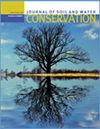Agriculture intensification as a critical step to enhance sustainable productive systems
IF 2.6
4区 农林科学
Q2 ECOLOGY
引用次数: 0
Abstract
Soil health refers to the soil’s ability to function as a living ecosystem that sustains plants, animals, and humans, with optimal biological, chemical, and physical characteristics that allow high crop yields and other essential ecosystem functions (Magdoff and Van Es 2021; USDA NRCS 2020). Soil plays a crucial role in providing several ecosystem services, including food and energy production, primarily through agriculture, water quality regulation, and nutrient cycling (Costanza et al. 1997). To increase ecosystem services while maintaining soil health, agricultural conservation practices can help reduce the negative impacts of modern agriculture practices. Conservation agriculture is based on four principles: (1) no-till to minimize mechanical soil disturbance, (2) crop rotation or diversification, (3) keeping the soil covered more than 30% annually, and (4) optimal nutrient management. Implementing all four principles together is crucial for maintaining soil health, as implementing only one or two principles may not positively impact soil health (Augarten et al. 2023; Pittelkow et al. 2015). In recent years, agriculture sustainable intensification (SI) has gained popularity as an agricultural practice that involves growing more crops per unit of time to make more efficient and intensive use of environmental resources. SI offers several benefits for soil health, including improved water usage efficiency, reduced hydric erosion and percolation, and increased soil organic matter (SOM) and …农业集约化是加强可持续生产系统的关键步骤
土壤健康是指土壤作为维持植物、动物和人类生存的有生命的生态系统发挥作用的能力,它具有最佳的生物、化学和物理特性,可实现作物高产和其他基本的生态系统功能(Magdoff 和 Van Es 2021 年;USDA NRCS 2020 年)。土壤在提供多种生态系统服务方面发挥着至关重要的作用,包括主要通过农业生产食物和能源、调节水质和养分循环(Costanza 等,1997 年)。为了在保持土壤健康的同时增加生态系统服务,农业保护措施可帮助减少现代农业做法的负面影响。保护性农业基于四项原则:(1) 免耕以最大限度地减少对土壤的机械扰动,(2) 轮作或多样化,(3) 每年保持土壤 30% 以上的覆盖率,以及 (4) 最佳养分管理。同时执行所有四项原则对保持土壤健康至关重要,因为只执行一项或两项原则可能不会对土壤健康产生积极影响(Augarten 等,2023 年;Pittelkow 等,2015 年)。近年来,农业可持续集约化(SI)作为一种在单位时间内种植更多作物以更高效、更集约地利用环境资源的农业实践越来越受欢迎。农业可持续集约化为土壤健康带来了多种益处,包括提高用水效率、减少水土流失和渗漏、增加土壤有机质(SOM)和...
本文章由计算机程序翻译,如有差异,请以英文原文为准。
求助全文
约1分钟内获得全文
求助全文
来源期刊
CiteScore
4.10
自引率
2.60%
发文量
0
审稿时长
3.3 months
期刊介绍:
The Journal of Soil and Water Conservation (JSWC) is a multidisciplinary journal of natural resource conservation research, practice, policy, and perspectives. The journal has two sections: the A Section containing various departments and features, and the Research Section containing peer-reviewed research papers.

 求助内容:
求助内容: 应助结果提醒方式:
应助结果提醒方式:


